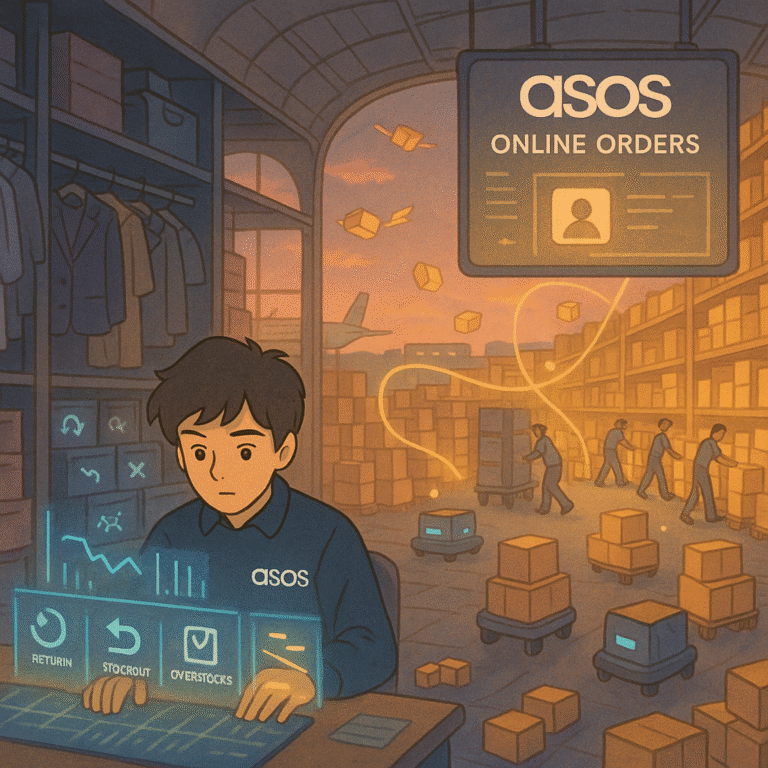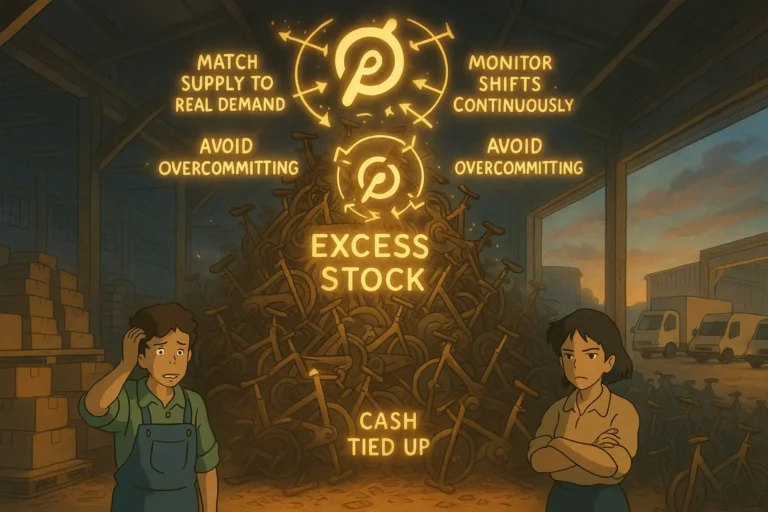
H&M's inventory failure
H&M’s inventory failure in 2018 cost the company $4 billion. Companies occasionally lose money, but this particular case was particularly shocking to investors, analysts, and experts across the industry. Why?
Article Brief & Key Nuggets:
- The $4B H&M’s inventory disaster in 2018 exposed the risks of slow supply chains and poor demand forecasting in retail.
- The buildup of nine weeks of unsold stock forced massive markdowns, profit loss, and long-term brand damage.
- H&M responded by reshaping its supply chain: faster sourcing, AI forecasting, RFID tracking, and outlet expansion.
- The disaster offers valuable lessons in inventory management for retailers and African supply chains alike.
H&M’s $4 Billion Inventory Disaster in 2018
Fast fashion should mean fast supply chains.
At least that’s the assumption many logistics and supply chain professionals still hold. However, when H&M, one of the largest names in fast fashion, announced in 2018 that it was holding $4 billion in unsold clothing, that assumption was called into question.
Behind this number were nine weeks of excess inventory, slow product cycles, and misjudged trends. The ripple effect of H&M’s inventory failure became a case study in how supply chain speed, flexibility, and forecasting are no longer optional—they’re survival tools.
Why H&M Stockpiled Nine Weeks of Inventory
H&M’s $4B disaster, roughly 17–18% of H&M’s annual sales, occurred because the company was slow to acknowledge that its once-winning inventory model had fallen behind. At the time, the company’s supply chain took six months to push a design from concept to store shelves.
That kind of lead time made sense years earlier, when trends were seasonal and slow. But social media has changed the market and shortened fashion cycles. Online-only retailers were turning around new styles in two to four weeks. And H&M’s inventory model couldn’t keep up.
The company made its bets early. Around 80% of its products were designed well in advance of the season. The risk of that decision was typical of the time. If customer demand shifted in-season, there was no turning back.
That year, customer preferences did shift. And H&M’s designs didn’t connect with shoppers.
Sales dropped, inventory remained stagnant, and warehouses became overcrowded.
Then the weather turned strange. An unusually warm winter and a cold spring meant seasonal lines stayed on the rack.
H&M blamed the weather in its press statements, investors blamed bad planning, and analysts pointed out that competitors like Zara, Boohoo, and ASOS were adjusting in real-time. But H&M was not.
The company’s online infrastructure didn’t help either.
Its digital channel was underperforming, deliveries were delayed, and many of its physical stores were underutilized or outdated. That meant that even when customers wanted to shop online, H&M couldn’t deliver fast enough—or with the right products.
Read more: Lessons From McDonald’s & Yum Brands’ Expired Meat Disaster in China.
How H&M Cleared $4 Billion in Unsold Inventory
H&M launched a discount war to empty its warehouses.
Following H&M’s inventory failure in 2018, the company initiated deep markdowns, up to 47%, across stores globally. Customers were bombarded with red sale signs, and storefronts became clearance outlets. A faux-leather jacket that might have sold for $40 was marked down to $8.99.
These sales helped reduce stock but came with steep losses. H&M’s gross margin dropped, and the promotions cannibalized its full-price business. Selling off old inventory ate into profit and diluted brand value.
To offload excess stock more discreetly, H&M created a discount outlet brand—AFOUND, which was later sold to Secret Sales in 2024. AFOUND allowed H&M to push unsold goods away from their main retail stores.
The company also opened automated logistics centers to move products faster and, where necessary, may have resorted to writing off or recycling inventory that couldn’t be sold.
Even with these actions, by mid-2018, stock-in-trade still hovered around 18% of sales. That ratio should have been closer to 12%. The company was trying to empty a bucket while the tap was still running.
The Financial Implications of H&M’s Inventory Failure & Supply Chain Strategy
The financial hit of the inventory mistake was brutal on H&M.
Operating profit for Q1 2018 dropped 62%. It was the worst quarter in over a decade, and H&M’s stock hit its lowest point in 10 years, down nearly 66% from its 2015 peak.
Investors fled.
This wasn’t just a quarterly dip. It was a loss of confidence. At the time, the market saw that H&M could no longer predict fashion or manage its supply chain. A brand once seen as agile now looked stuck.
The company’s full-year profit for 2018 fell to its lowest in many years (H&M would not see a year-over-year quarterly profit increase again until late 2019).
The markdowns that cleared the inventory also taught customers to wait for discounts. This damaged the perceived value of new collections. Promotions stopped being a tactic and became an expectation.
Inventory isn’t just fabric and thread. It’s tied-up cash, strained storage, damaged brands, and lost customers.
Read more: Starbucks’ Ethically Sourced Coffee: Behind The Scenes.
H&M Rebuilt Its Supply Chain
H&M’s CEO, Karl-Johan Persson, admitted, “The start of the year has been tough… 2018 is a transitional year as we accelerate our transformation.”
The company knew it had to change fast.
H&M announced a transformation plan that touched nearly every part of its supply chain. It wasn’t optional.
- Faster Sourcing: H&M increased proximity sourcing in Europe to cut delivery lead times.
- Automation: The company opened new logistics centers with automation to speed up fulfillment.
- Real-time Visibility: H&M implemented RFID tracking across its stores to monitor stock levels in real-time and redistribute stock quickly.
- Outlet Diversion: Afound was expanded as an off-price channel to manage future excess inventory without hitting brand perception.
- Omnichannel Integration: The company upgraded its e-commerce platform, merged store and online inventories, and introduced click-and-collect services.
- Forecasting with Data: H&M invested in AI and analytics to improve demand prediction and trend detection. More of its designs are now produced in-season using real-time sales data.
Thanks to these changes, H&M aimed to bring its inventory levels back in line. Persson set a target to reduce inventory to around 12–14% of sales by 2019, down from ~18% in 2018.
Although the changes did not solve the problem overnight, they slowed inventory growth and began restoring margins by 2019.
Lessons From H&M’s Inventory Failure
H&M’s disaster wasn’t unique. But it was big enough to force reflection.
Here’s what every logistics professional should carry forward:
1. Speed Protects Margins.
A six-month product cycle is too long for a trend-driven industry. The closer your production is to your customers—both physically and in data—the better your chance of staying relevant.
2. Forecasting Isn’t About Guessing. It’s About Listening.
AI, customer data, and even social media signals can help, but they only work if you shorten the decision loop. Don’t bet big six months ahead. Bet small, measure fast, adjust quickly.
3. Inventory is Capital.
Carrying too much slows you down, but carrying the wrong kind can sink you. Maintain a lean inventory, with flexibility built into your model.
4. Discounts Destroy Brands When Used to Cover Poor Planning.
Once customers expect constant promotions, you’ve lost pricing power. Move excess through separate channels or secondary brands.
5. Have a Pressure Valve.
Pressure valves don’t hurt. If you can, have one. Off-price channels like Afound are not luxuries. They’re strategic tools to protect the core business when things go wrong.
Read more: Walmart’s Project Gigaton: The Story and Lessons Behind it.
What African Supply Chains Can Do Differently
Africa’s supply chains face different constraints, but the lessons still hold.
1. Shorten Production Lead Times By Sourcing Closer.
Many African retailers rely heavily on imports from Asia with long lead times. By growing local manufacturing capacity or nearshoring within the continent, they can reduce inventory risks.
2. Use Mobile Data to Forecast Demand.
Many African consumers shop online via mobile. Retailers should invest in tools that collect and analyze customer behavior on mobile platforms. This makes it easier to adapt offers in real-time.
3. Don’t Overcommit Inventory in Advance.
Even in slower markets, fashion and consumer trends change fast. Start with smaller batches, test demand, then scale production.
4. Build Liquidation and Resale Paths Early.
Whether through community markets, outlet stalls, or digital resale platforms, retailers should have a system for clearing unsold goods without harming their primary brand.
5. Use Basic Tech to Gain Visibility.
Full RFID might be too costly for some operations. But basic SKU tracking, real-time POS systems, and regular cycle counts can offer 80% of the benefits at a fraction of the cost.
Supply chain leaders in Africa are not behind. They’re building from scratch with fewer bad habits. And that’s an advantage.
By applying lessons from H&M’s inventory failure, they can skip years of trial and error and build leaner, smarter, and faster supply chains from day one.
H&M’s Inventory Failure/Disaster Wasn’t About Clothes.
It was about control.
- Control of the supply chain.
- Control of demand signals.
- Control of brand value.
In losing that control, H&M handed competitors an opening and investors a reason to walk away. But what the company did next—investing in data, automation, speed, and separate channels helped it survive.
And for anyone managing inventory today, especially in emerging markets, those actions are more than damage control. They’re a blueprint.

Obinabo Tochukwu Tabansi is a supply chain digital writer (Content writer & Ghostwriter) helping professionals and business owners across Africa learn from real-world supply chain wins and setbacks and apply proven strategies to their own operations. He also crafts social content for logistics and supply chain companies, turning their solutions and insights into engaging posts that drive visibility and trust.








